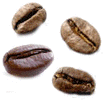...Best of Sicily presents... Best of Sicily Magazine. ... Dedicated to Sicilian art, culture, history, people, places and all things Sicilian. |
by Roberta Gangi | ||
Magazine Index Best of Sicily Arts & Culture Fashion Food & Wine History & Society About Us Travel Faqs Contact Map of Sicily |
If you ask for a normal caffé, you'll get a strong, dense espresso --a term rarely used by Italians because that's the way coffee is normally served here. Incidentally, Italians usually serve coffee in a bar, even if it resembles a French café. (The difference between the Italian pronunciation of caffé and café is too subtle to explain here.) A caffé that is slightly diluted is lungo; one that is denser than normal is stretto. If it has a few drops of steamed cream or milk in it, it's macchiato. An espresso with twice the strength and volume of an ordinary, small cup is a doppio (double). This may look like a lungo but it's not. Typically, Italians indulge in these espresso coffees on the run, standing at a crowded coffee bar. There's no shortage of these in Sicily. In the largest cities they seem to be everywhere, and in Palermo moreso than in Catania. Cappuccino is so-called because its light brown color is similar to that of the habits worn by Capuchin monks. This is essentially an espresso lungo topped off with hot, foamy milk and perhaps a sprinkling of chocolate. In Italy, this is a breakfast or mid-morning drink. Only foreigners ever drink it after noon, and some bars turn off the steam apparatus by lunchtime. Caffé latte is an espresso with fresh milk that is poured on top but not steamed into a froth. It's a little heavier than a cappuccino but, like that coffee, usually a morning drink. Some purists consider caffé latte a children's drink. An americano, as its name implies, is similar to the typical American cup of coffee. Even an American should never ask for this. Few Italian bartenders can make it. A caffé corretto is an espresso served with a spoonful of amaretto, grappa or other dry spirit. Caffé freddo (cold coffee) is more popular in Sicily than in other parts of Italy. This unique summer drink is coffee that is literally frozen into a granular substance which is almost --but not quite-- liquid. Recently, in September 2005, a Sicilian establishment was voted Italy's best coffee bar of the year. This was Spinnato in Palermo. In Sicily, most coffee bars will offer you a variety of biscotti (cookies), cornetti (crescent rolls) and other temptations that go well with coffee. About the Author: Roberta Gangi has written numerous articles and one book dealing with Italian cultural and culinary history, and several food and wine articles for Best of Sicily Magazine. | |
Top of Page |
 A number of Sicilian establishments roast and grind coffee beans into something suitable for brewing but coffee itself is not, strictly speaking, an Italian drink. Coffee (from the coffea arabica berry) first made its way into Europe commercially in the seventeenth century, and the Venetians and were probably the first Italians to appreciate it. The coffee plant is native to Ethiopia, and late in the nineteenth century several Italian companies began to import it directly in exceptional quantities. This profitable trade remained fairly steady even throughout some infamous Italian misadventures which briefly disturbed Italy's commerce in the region (most notably military defeats in Ethiopia in 1896 and again in 1941). What makes Italy special in coffee circles is that here coffee is served in a variety of ways.
A number of Sicilian establishments roast and grind coffee beans into something suitable for brewing but coffee itself is not, strictly speaking, an Italian drink. Coffee (from the coffea arabica berry) first made its way into Europe commercially in the seventeenth century, and the Venetians and were probably the first Italians to appreciate it. The coffee plant is native to Ethiopia, and late in the nineteenth century several Italian companies began to import it directly in exceptional quantities. This profitable trade remained fairly steady even throughout some infamous Italian misadventures which briefly disturbed Italy's commerce in the region (most notably military defeats in Ethiopia in 1896 and again in 1941). What makes Italy special in coffee circles is that here coffee is served in a variety of ways.